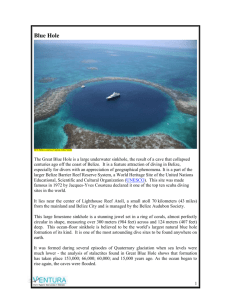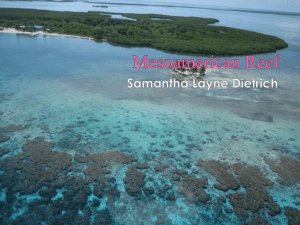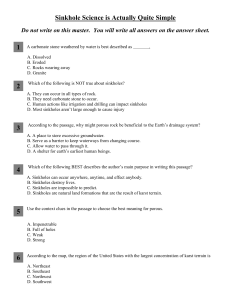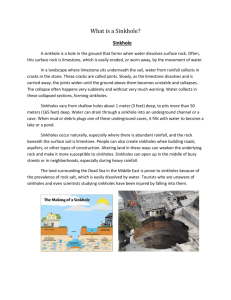BlueHole_Out
advertisement
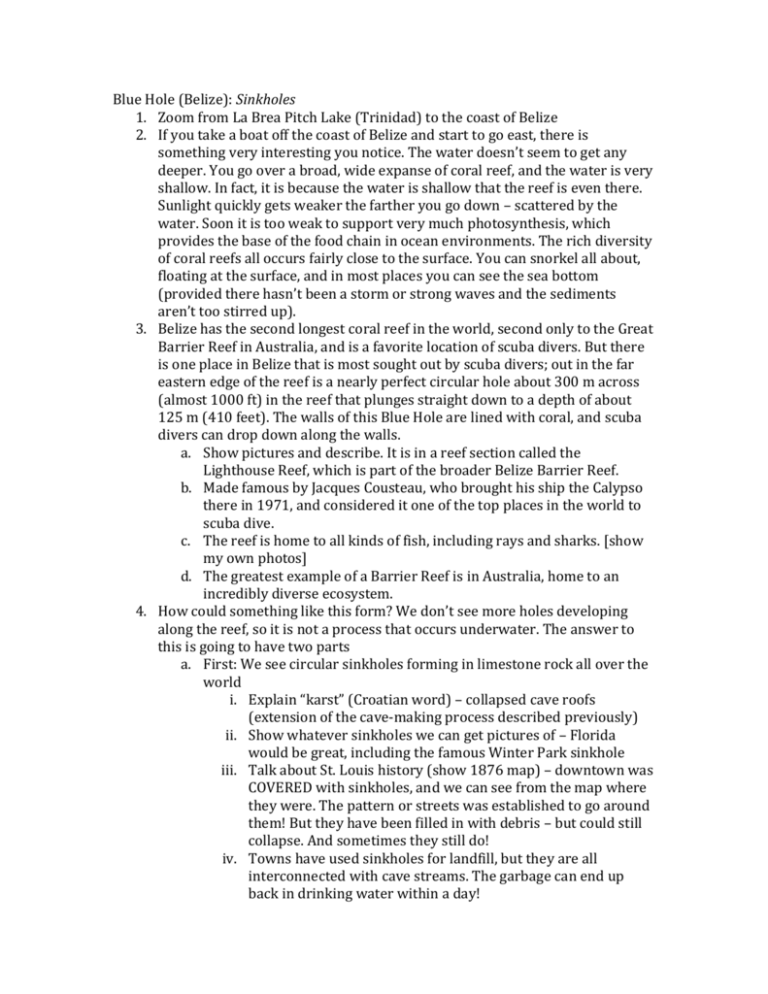
Blue Hole (Belize): Sinkholes 1. Zoom from La Brea Pitch Lake (Trinidad) to the coast of Belize 2. If you take a boat off the coast of Belize and start to go east, there is something very interesting you notice. The water doesn’t seem to get any deeper. You go over a broad, wide expanse of coral reef, and the water is very shallow. In fact, it is because the water is shallow that the reef is even there. Sunlight quickly gets weaker the farther you go down – scattered by the water. Soon it is too weak to support very much photosynthesis, which provides the base of the food chain in ocean environments. The rich diversity of coral reefs all occurs fairly close to the surface. You can snorkel all about, floating at the surface, and in most places you can see the sea bottom (provided there hasn’t been a storm or strong waves and the sediments aren’t too stirred up). 3. Belize has the second longest coral reef in the world, second only to the Great Barrier Reef in Australia, and is a favorite location of scuba divers. But there is one place in Belize that is most sought out by scuba divers; out in the far eastern edge of the reef is a nearly perfect circular hole about 300 m across (almost 1000 ft) in the reef that plunges straight down to a depth of about 125 m (410 feet). The walls of this Blue Hole are lined with coral, and scuba divers can drop down along the walls. a. Show pictures and describe. It is in a reef section called the Lighthouse Reef, which is part of the broader Belize Barrier Reef. b. Made famous by Jacques Cousteau, who brought his ship the Calypso there in 1971, and considered it one of the top places in the world to scuba dive. c. The reef is home to all kinds of fish, including rays and sharks. [show my own photos] d. The greatest example of a Barrier Reef is in Australia, home to an incredibly diverse ecosystem. 4. How could something like this form? We don’t see more holes developing along the reef, so it is not a process that occurs underwater. The answer to this is going to have two parts a. First: We see circular sinkholes forming in limestone rock all over the world i. Explain “karst” (Croatian word) – collapsed cave roofs (extension of the cave-making process described previously) ii. Show whatever sinkholes we can get pictures of – Florida would be great, including the famous Winter Park sinkhole iii. Talk about St. Louis history (show 1876 map) – downtown was COVERED with sinkholes, and we can see from the map where they were. The pattern or streets was established to go around them! But they have been filled in with debris – but could still collapse. And sometimes they still do! iv. Towns have used sinkholes for landfill, but they are all interconnected with cave streams. The garbage can end up back in drinking water within a day! v. St. Louis used the sinkholes and caves as their first sewage system, until it all backed up during a large storm! b. Second: The sea-level has recently gone up, but 400 feet since the end of the last Ice Age. So, the coral reef of Belize is shallow because it is actually continent that has been flooded. And the reef sits on top of a layer of limestone that is fossilized reef from an ancient time. The Blue Hole is a sinkhole that formed when it was above water, with empty caves below the surface, and a roof fell in. Now that the sea level has risen, the sinkhole is below water, and new coral growing around and within it. i. Belize isn’t the only place where continent is under water. Much of the world’s continents are ringed by a “continental shelf” that can extend seaward for hundreds of miles in places. ii. In fact, 39% of the Earth’s surface is continent, but 30% of the Earth’s surface is land 9% of Earth’s surface (almost a ¼ of continents is under water) is continental shelf. iii. Continental shelf turns out to be incredibly important for fishing iv. Also has important consequences for coastlines around the world, flooding valleys, and we will come back to it several times (fjords, Rock of Gibraltar, etc.) v. Large numbers of Cenotes (sinkholes) in Central America, such as the Yucatan, that are connected by underground cave streams. c. Why has the sea level risen so quickly? We sort of know the answer to this. i. Show graph of sea level rise over the past 20,000 years. ii. Show map of shrinking North America ice sheet. iii. Explain Ice Age cycles and Milankovitch cycles of gravitational pull from Jupiter and Saturn, etc. --- show graph of temperature change over past 500,000 years. [note: this is separate from the global cooling that we talked about in the Himalayas lecture that resulting from the erosion of the Himalayas]. iv. The temperature changes drive a corresponding change in carbon dioxide in the atmosphere, which then changes in the temperature in a positive-feedback loop. v. [Briefly explain Greenhouse effect] vi. So, now we know why the temperature rises at the end of an ice age [driven by milankovitch cycles]; but why so sudden? vii. Perhaps because of sudden release of methane in ocean sediments that were now exposed. Spiked a runaway greenhouse that quickly turned the climate warm. d. In what is now Belize, the Blue Hole was just another sinkhole. With so much ice on land near the poles, it was almost 400 ft above sea level (for scale, St. Louis is 450 feet above sea level!). And the bottom of the cave went down about 400 feet, right about at sea level. e. There were caves drying out underground, and the roof of one fell in. It was at just the right elevation so that now, with the sea level risen, it is just below sea level, perfect conditions for the growth of coral, which supports all kinds of life, and is a fantastic place to go scuba diving. f. By looking at stalactites along the walls of the Blue Hole, we can actually determine that the cave formed during several episodes of extreme glaciation, when the water table dropped very low – about 153,000/66,000/60,000/15,000 years ago (leaving ledges at depths of 29, 49, and 91 meters). g. The Blue Hole is aesthetically beautiful, but the geological clues here reveal a history tied in with global events occurring around the world. 5. Top 5: a. Xiaozhai tiankeng (China) and Dashiwei – world’s largest sinkholes, at 662 m deep and 626 meters wide, and 613 m x 600 m. b. Zacaton (Mexico) – deepest water-filled sinkhole (339 m), with floating travertine islands. c. Dean’s Blue Hole (Bahamas) – deepest ocean Blue Hole – 202 meters. d. Sacred Cenote at Chichen Itza (Mexico) e. Special Mention: Aricebo Radio Telescope (Puerto Rico) – world’s largest radio telescope in the world – 305m – built inside a sinkhole! Questions: 1. What is the connection between cave systems and sinkholes? 2. What would the Blue Hole look like if the sea level hadn’t risen?
